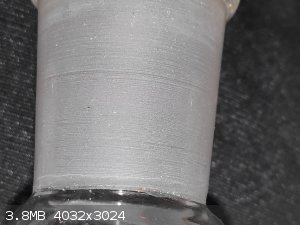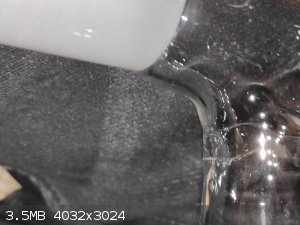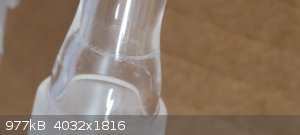chaosday
Harmless

Posts: 6
Registered: 8-12-2021
Member Is Offline
|
|
Glassware question
I got a distillation kit for Christmas. After looking at it, I quickly noticed that a lot of the pieces had many air bubbles trapped inside of them
and because that was a safety hazard, I ordered a retoure. The seller of the product however sent me a new distillation set instead of taking the old
one back. The new one arrived today, and it seems to have the same bubble problem as the old one, however the bubbles are a lot smaller and there is
less of them. Below you can see some pictures of the bubbles in the glass. Are these a safety hazard while distilling?
 
|
|
|
Rainwater
National Hazard
   
Posts: 919
Registered: 22-12-2021
Member Is Offline
Mood: indisposition to activity
|
|
I got a thermowell with the same defect from usalabs. They assured me it was fine and extended the warranty they provided.

I set up a test bath with some water, silicone oil and high stirring. Attached a reflux condenser cranked my hotplate to max then, ran it for 24
hours. So far so good.
"You can't do that" - challenge accepted
|
|
|
Chemetix
Hazard to Others
  
Posts: 375
Registered: 23-9-2016
Location: Oztrayleeyah
Member Is Offline
Mood: Wavering between lucidity and madness
|
|
That white ring of micro bubbles is where the glass was cut and ground with a diamond saw (most likely) and then fused in the flame to trap
microvoids. Sometimes, at the microscopic level, the peaks of the jagged surface absorb so much heat so quickly the glass boils and there is a
microscopic level of bubbles from this phenomena as well.
It really doesn't affect the glass in any way unless it's particularly severe and then you'd really know it. Grinding the surface to make a tapered
joint is a process that makes the glass weaker and more prone to breakage, so some perspective about what constitutes acceptable "damage " to glass
needs to be taken. I like to make really clean joins, but often customers don't want the premium price that incorporates the extra time to wash and
clean the cut then the slow heating to make sure the join is perfect.
|
|
|
Dr.Bob
International Hazard
    
Posts: 2732
Registered: 26-1-2011
Location: USA - NC
Member Is Offline
Mood: No Mood
|
|
I have seen small bubbles in all glassware, even the best, but the cheap stuff has more. Unless you are doing highly critical or dangerous work, I
would not worry about it. I use 10-30 year old glass every day to do real chemistry, and I have never had a flask break in normal use unless it was
dropped, hit, or otherwise shocked. But if you are worried, I would stick to US made stuff from Kontes, ChemGlass, Ace or similar. You can buy it
cheap on Ebay or other places easily and cheap right now, much better than new cheap Chinese stuff.
The way I break most is trying to wash it or trying to unstick joints that got stuck, just did it again last week, got a trace of LAH soln on a
additioon funnel top joint, and almost had to break it off, but got it free from the flask and then am working to remove the top adapter still.
Tried soaking it is acid, but no luck yet. Maybe sonication, maybe a torch, maybe just leave it stuck and move on. Had a real glass blower unstick
a few for me a while back, but that gets expensive.
|
|
|
MadHatter
International Hazard
    
Posts: 1339
Registered: 9-7-2004
Location: Maine
Member Is Offline
Mood: Enjoying retirement
|
|
Bomex
I learned to avoid this type of glass. Doesn't tolerate heating too well. Had it crack
on me(beaker). Other types such as Schott-Duran, Simax, Kimax, Pyrex and
others are excellent in my experience.
From opening of NCIS New Orleans - It goes a BOOM ! BOOM ! BOOM ! MUHAHAHAHAHAHAHA !
|
|
|
SWIM
National Hazard
   
Posts: 970
Registered: 3-9-2017
Member Is Offline
|
|
I've seen pieces from top glassmakers with bubbles as well.
Ace is great stuff in my opinion, but I've got Ace flasks that have lots of bubbles.
It's usually large older glassware like 3 liter flasks and larger, but some of these I have were used for years before I got them and have continued
to survive by unthinking abuse for years since then.
I've seen plenty of those lines of tiny bubbles too, but never knew what they were until now.
My personal glassware is probably bubblier than most because I tend to sell the pristine looking stuff and keep the stuff that's still good but
doesn't look as good for personal use.
I also avoid Bomex glass.
I heard somewhere that they used to be good, but were sold and the new management just doesn't seem to give a damn about quality control.
If what I heard is true (haven't bothered to check) they've been kind of shoddy for 20 years or so.
EDIT: However if I'm doing something at really high temperatures like over 250 degrees I do try to use bubble free and scratch free glass if I have
such available.
I actually keep some flasks for just these uses and treat them very carefully to maintain their pristine condition (store well wrapped and padded,
keep them out of contact with hard surfaces, and don't put them down with stuff in them unless it's on a cork ring or a soft mantle)
I'm not sure how helpful this really is, but I've read that even tiny scratches can lead to failure at high temperatures and under high thermal
stress, so why take a chance.
I've never had a flask at 300C break on me spilling hot whatever all over the place and I sure don't want to find out what that's like.
[Edited on 1-2-2022 by SWIM]
|
|
|